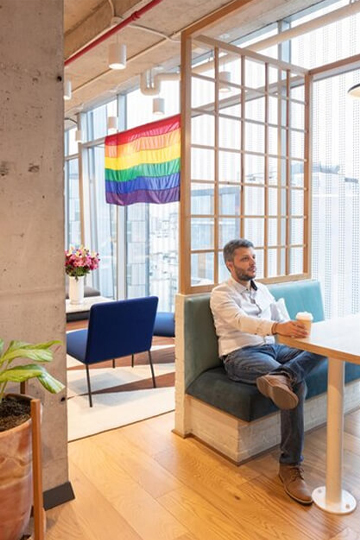Job Titles Are Cheap — Clarity Is What’s Missing

Job Titles Are Cheap — Clarity Is What’s Missing 16.04.25 It’s easy to hand out titles. It’s harder to define what they actually mean. That’s the real issue inside many growing organisations today: roles that sound impressive but mean very little in practice. Job descriptions that were copy-pasted from competitors. Reporting lines that change with every reorg. And an unspoken culture where no one really knows who owns what — until something goes wrong. We call it agility. In reality, it’s ambiguity. Startups and scale-ups are especially prone to this. When you’re growing fast, the priority is usually hiring — not precision. You need people on the ground. You need energy. You need coverage. But somewhere along the way, you end up with three “Leads” doing different things, two “Heads of” managing no one, and a “Manager” who’s actually just a solo operator. This lack of clarity doesn’t just confuse staff. It undermines performance. When people don’t know exactly what’s expected of them, they default to what feels safe. That means tasks get duplicated. Strategic work gets postponed. And the real risks — the gaps between roles — are nobody’s job. A London-based media firm learned this the hard way in 2023. Two departments shared responsibility for external communications. One managed partnerships, the other handled press. Neither thought to monitor influencer activity — until a sponsored post went out with incorrect messaging during a live campaign. The cost wasn’t catastrophic. But it was entirely avoidable. The gap wasn’t in the plan — it was in the roles. Titles are rarely the problem on their own. The problem is that titles are used as shortcuts — to avoid hard conversations about scope, priority, and accountability. Ask someone what they do, and they’ll tell you their title. Ask them what decisions they’re responsible for, and you’ll get a pause. That pause is the problem. Organisations that take job design seriously don’t stop at titles or even job descriptions. They define decision rights. They clarify authority levels. They make sure that everyone — from leadership down — knows where the boundaries are. That doesn’t reduce flexibility. It enables it. Because once everyone understands the lanes, you can actually move faster without crashing into each other. Job clarity also plays a critical role in progression. If no one knows what a role involves, how do you prepare someone to grow into it? Or evaluate whether they’re ready? Too often, performance reviews rely on soft language: “shows potential”, “adds value”, “strong presence”. What’s missing is a concrete sense of whether the person has delivered against a defined set of responsibilities. And that creates bias. The people who get ahead aren’t always the most effective. They’re the most visible. Or the most confident. Or the most familiar. Clarity levels the playing field. It forces decisions to be made based on substance — not style. One financial services firm in Leeds tackled this in a straightforward way. Every role, regardless of level, had to be documented in terms of five questions: What decisions can this role make alone? What does this role influence, but not own? What information does this role need to perform well? What does success look like after six months? What are the top three risks if this role is done poorly? It wasn’t a complicated framework. But it changed how teams spoke about work. Promotions became clearer. Onboarding improved. Handover notes had purpose. And staff reported higher satisfaction in understanding “what they were actually meant to do.” There’s another side to this: retention. People don’t leave companies just because of pay. They leave because they feel stuck. Or unclear. Or invisible. When roles are ambiguous, contribution becomes hard to see. And when you’re not sure whether your work matters, it’s easier to disengage. This is especially true in hybrid teams. Without hallway conversations or casual check-ins, employees rely on structure to anchor their role. If that structure is missing, isolation sets in quickly. Clear role design isn’t bureaucracy. It’s basic respect. If you want a high-performing team, don’t start with perks or performance plans. Start with definition. Not just what people are called — but what they’re trusted to deliver. If you can’t describe a role in terms of decisions and outcomes, it probably isn’t working. And if your people spend more time clarifying who owns what than doing the work itself, it’s not a culture problem. It’s a structure one. Fix that — and everything else moves faster.
Why No One Wants to Investigate the Boss — and What It’s Costing You

Why No One Wants to Investigate the Boss — and What It’s Costing You 12.05.25 It’s the unspoken rule in many organisations: if the person being complained about is senior enough, the bar for action is suddenly higher. Allegations get “noted”. Processes drag. HR is told to “handle it delicately”. Words like “culture fit” and “performance context” start appearing in meeting notes. And slowly — sometimes quietly — the issue goes unresolved, or disappears into a leadership reshuffle. The problem isn’t always bad faith. It’s fear. Fear of conflict. Fear of damaging relationships. Fear of reputational fallout if a senior name ends up in an official report. But that fear is costing companies more than they realise. When the complaint involves someone with power — a department head, a partner, a founder — everything changes. HR feels pressure to protect the organisation’s image. Legal steps in early. The goal shifts from investigation to containment. But here’s the thing: the staff already know. Word spreads faster than any internal policy. They see who’s untouchable. They see what happens when someone raises a flag. And they take note. In 2023, a tech company in Cambridge lost three of its most experienced women in under four months. Each had raised concerns, informally, about the behaviour of the same VP. Nothing abusive. But patterns. Dismissive remarks. Repeated interruptions in meetings. Credit taken. HR logged the concerns, but waited for a “formal complaint” before acting. That complaint never came. But the resignations did. It wasn’t the VP that damaged the team. It was the response. Organisations like to believe that process alone will solve this. That if policies are followed and forms are completed, fairness is guaranteed. But when a junior staff member sees that senior figures aren’t held to the same standard — that investigations are handled differently depending on rank — trust evaporates. And with it goes psychological safety, engagement, and long-term retention. The data backs this up. A 2022 report from the Chartered Institute of Personnel and Development found that employees were 41% less likely to report misconduct when the person involved held decision-making power over their careers. In other words, the people who most need protecting are the least likely to speak. That’s not a policy problem. That’s a credibility problem. What’s the fix? First, stop pretending seniority equals immunity. If anything, senior leaders should be more accountable. They set tone, shape culture, and hold influence. If their behaviour crosses a line, the stakes are higher — not lower. Second, remove ambiguity. Your process for complaints involving executives should be just as clear, just as public, and just as consistent as it is for everyone else. If the policy has a footnote about “board oversight” or “discretion in exceptional cases”, staff will see straight through it. Third, don’t wait for disaster. Run after-action reviews on every serious complaint. What worked? What didn’t? What did people say informally that never made it into the report? These reviews won’t solve the problem overnight. But they’ll show you where the cracks are — and who’s falling through them. A law firm in the Midlands now does this quarterly. Every complaint — formal or informal — is reviewed by a neutral panel of HR and operations staff. Names are removed. Cases are anonymised. But patterns are tracked. It’s not perfect, but it’s progress. And the staff know it’s happening. That alone has started to shift the culture. And finally — support your HR people. Investigating someone senior is not easy. It requires skill, authority, and air cover. If the people running your process don’t feel backed, they’ll default to caution. Or worse, silence. Too many HR teams have been burned by trying to “do the right thing” and finding themselves sidelined. Or worse, blamed. Senior leaders often say they want transparency. But when that transparency involves one of their peers, the language shifts. Suddenly, it’s about tone. Intent. “Perception gaps.” We all know what that means. Here’s the uncomfortable truth: most organisations don’t fail because someone misbehaved. They fail because they didn’t deal with it properly. You can’t claim to care about culture if your culture depends on who’s being accused. You can’t claim to care about trust if the person raising the concern ends up isolated. And you can’t claim to be a modern, ethical business if you’re still protecting seniority over principle. The good news? This is fixable. But only if you’re willing to stop asking how to contain the fallout — and start asking how to earn credibility.
Workforce Planning Only Works If You Stop Lying to Yourself

Workforce Planning Only Works If You Stop Lying to Yourself 19.11.24 Most organisations claim they’re doing workforce planning. What they’re really doing is guessing. They take last year’s structure, add or subtract a few heads, run a spreadsheet, and call it a plan. HR is asked to build models based on hiring intentions that shift every quarter. Managers say they need more staff, then delay recruitment once budget is approved. And leadership is shocked when critical roles stay unfilled for months or the wrong people get promoted into roles they were never built for. This isn’t strategy. It’s institutionalised short-termism. The first problem? No one wants to be honest about what work is actually being done — and by whom. Job descriptions haven’t been updated in three years. Teams are still structured around functions that no longer exist. There are three people doing the same task under different job titles. And still, headcount requests keep coming. In 2023, a logistics firm based outside Sheffield hit a wall when two major contracts fell through. The finance team flagged a cost problem. HR flagged a workload issue. Operations said they needed ten new hires. The truth? Four people were handling work that could’ve been automated. And another five were doing tasks nobody had re-evaluated since 2019. It wasn’t a headcount issue. It was an alignment issue. One that could have been solved six months earlier if someone had stopped and looked properly. Workforce planning shouldn’t be owned by HR alone. If the commercial team isn’t involved, the plan will always lag behind business reality. But what usually happens is this: HR builds the framework, asks for input, and waits. Managers delay, throw in vague numbers, or don’t reply. The final product gets shared, nodded at, and buried in a folder. Until something breaks. Here’s the fix: force the conversation. Don’t ask “How many heads do you need?” Ask “What work won’t get done if you don’t have them?” That one question will tell you everything you need to know about priorities — and who’s asking for bodies out of habit. Then there’s the talent hoarding problem. Managers hold on to people they don’t need because they’re afraid they won’t get the headcount back later. So succession planning gets stuck. Internal mobility slows down. High performers get restless and leave — not because they don’t like the company, but because they can’t see a way forward. It’s not the people that are broken. It’s the system that tells managers to hoard, not build. One fintech company in London ran a quarterly “talent release review” in 2024. Every leader had to put forward one person from their team they were willing to develop out — not fire, but move. The goal was to unstick progression. It worked. Promotions sped up. Internal hires increased. People stopped leaving for the wrong reasons. Let’s talk about the numbers too. Everyone loves a dashboard. But most workforce plans rely on data that’s out of date by the time it’s presented. And even worse, no one is interrogating the logic behind it. If you’re planning workforce needs based on forecasted revenue, fine. But if that forecast changes — and it will — what’s the trigger for adjusting the plan? Who owns that recalibration? And how do you make sure your capability gaps don’t widen while everyone’s looking the other way? The organisations that get this right do one thing better than everyone else: they treat planning as active, not passive. It’s not a document. It’s a conversation — constant, difficult, and brutally honest. They ask: – What roles are critical? – What capabilities are at risk? – Where are we vulnerable? – Who’s leaving, and why aren’t we ready? The answers don’t always lead to pretty charts. But they tell you where to invest. And what to stop pretending is working. If you’re not prepared to look under the hood — properly, relentlessly — don’t bother writing a plan. It’ll just gather dust while the real problems grow sharper. Workforce planning isn’t about headcount. It’s about readiness. And you can’t fake readiness.
Comprehensive Strategies for LGBTQIA+ Inclusion in the Workplace

Comprehensive Strategies for LGBTQIA+ Inclusion in the Workplace 17.07.24 In today’s diverse work environment, creating an inclusive atmosphere for LGBTQIA+ employees is not just a moral imperative but also a business necessity. As we celebrate Pride Month, it’s crucial to remember that supporting sexual and gender diversity should be a year-round commitment. Here’s an expanded guide on how HR professionals and organizations can foster a more inclusive workplace for their LGBTQIA+ colleagues. 1. Normalize Gender Pronouns and Inclusive Language Encouraging the use of preferred gender pronouns can significantly impact workplace inclusivity. Companies like Adobe have integrated this practice into their Adobe For All initiative, incorporating pronouns in email signatures, Slack profiles, and Zoom names. This simple act demonstrates respect for individual identities and fosters an environment of recognition. Additionally, conduct regular language audits of company communications, policies, and marketing materials. Replace gendered terms with neutral alternatives. For instance, use “team” or “everyone” instead of “guys” or “ladies and gentlemen.” This shift in language helps create a more welcoming environment for all employees, regardless of their gender identity. 2. Establish LGBTQIA+ Support Groups and Employee Resource Groups (ERGs) Creating safe spaces for LGBTQIA+ employees to share experiences and challenges is crucial. AstraZeneca’s AZPride is an excellent example of an effective support group that provides training, visibility, and promotes inclusive policies. When establishing these groups, ensure they have: Clear objectives and responsibilities Adequate resources and budget Strong support from top leadership Inclusive membership policies that welcome allies IBM’s LGBTQ+ Council, for instance, partners with various business units to implement best practices and training programs, showcasing how these groups can drive organizational change. 3. Implement Inclusive Policies and Benefits Regularly review and update company policies to ensure they are inclusive and supportive of LGBTQIA+ employees. This includes: Anti-discrimination policies that explicitly protect sexual orientation and gender identity Inclusive healthcare benefits covering LGBTQIA+-specific needs, such as gender affirmation procedures Family leave policies that recognize diverse family structures, including same-sex partnerships and adoptive parents Johnson & Johnson sets a high standard by offering comprehensive coverage, including fertility treatments for same-sex couples. American Airlines extends LGBTQIA+ support to their suppliers, promoting diversity throughout their supply chain. 4. Celebrate Pride Month and Beyond While Pride Month is a significant event, support for the LGBTQIA+ community should extend throughout the year. Companies can: Change their logos to incorporate Pride colors during June Host internal and external events celebrating diversity Run awareness campaigns highlighting available resources Offer paid time off for employees to attend Pride events Make corporate donations to LGBTQIA+ charities Adobe, for example, raised over $20,000 for LGBTQ charities through various Pride Month activities, demonstrating tangible support beyond symbolic gestures. 5. Create Anonymous Feedback Channels Provide platforms for employees to anonymously suggest improvements or voice concerns related to LGBTQIA+ issues. Bain & Company uses different levels in their LGBTQ ERG to support employees at varying comfort levels in sharing their identity. This approach ensures that all voices can be heard, even from those who may not feel comfortable speaking openly. 6. Promote Visible Allyship Encourage visible support from allies throughout the organization. Accenture distributes rainbow lanyards and stickers to allies, creating a visually supportive environment. Consider implementing an ally training program to educate non-LGBTQIA+ employees on how to be supportive colleagues. 7. Focus on Intersectionality Recognize that LGBTQIA+ employees may belong to multiple marginalized communities. IKEA’s celebration of the International Day Against Homophobia, Biphobia, and Transphobia acknowledges the complexity of identities. Develop programs and policies that address the unique challenges faced by LGBTQIA+ individuals who are also part of other minority groups. 8. Conduct Regular Training Programs Implement ongoing diversity, equity, and inclusion training for all employees. Adobe’s diversity summit includes live-streamed sessions with guest speakers, providing continuous education on LGBTQIA+ matters. Ensure these training sessions cover topics such as unconscious bias, inclusive language, and the specific challenges faced by the LGBTQIA+ community in the workplace. 9. Engage in Legal and Policy Advocacy Companies like Coca-Cola actively engage in legislative efforts to support LGBTQIA+ rights. Consider taking a stand against discriminatory laws and practices, both internally and in the broader community. This could involve joining business coalitions that advocate for LGBTQIA+ rights or supporting legal challenges to discriminatory legislation. 10. Develop Mentorship Programs Establish mentorship programs specifically for LGBTQIA+ employees. These programs can: Pair LGBTQIA+ employees with senior leaders for guidance and support Create networking opportunities within the LGBTQIA+ community Help identify and address unique challenges faced by LGBTQIA+ professionals 11. Ensure Inclusive Recruitment Practices Review your recruitment processes to ensure they are inclusive and welcoming to LGBTQIA+ candidates. This might include: Using inclusive language in job postings Partnering with LGBTQIA+ job boards and professional networks Training recruiters on LGBTQIA+ inclusion and unconscious bias 12. Support LGBTQIA+ Initiatives Beyond the Workplace Extend your support for the LGBTQIA+ community beyond your organization. This could involve: Partnering with local LGBTQIA+ nonprofits for volunteer opportunities Sponsoring LGBTQIA+ events in the community Supporting LGBTQIA+-owned businesses in your supply chain By implementing these comprehensive strategies, organizations can create a more inclusive, supportive, and diverse workplace for all employees. Remember, fostering LGBTQIA+ inclusion is an ongoing process that requires continuous effort, education, and adaptation. As societal understanding of gender and sexuality evolves, so too should workplace policies and practices. By prioritizing these initiatives, companies not only support their LGBTQIA+ employees but also cultivate a more innovative, productive, and harmonious work environment for everyone.
Finding Fulfilment: Choosing a company that reflects what matters most

When considering their next career move, professionals would be wise to look beyond roles and responsibilities to closely evaluate company culture and values alignment. Will an organisation’s working style, leadership priorities and ethical standards conflict with or elevate your personal principles? The answer can mean the difference between disillusionment and deeply fulfilling work.
Beyond the paycheck: choosing a company aligned with your values for lasting happiness

Beyond the paycheck: choosing a company aligned with your values for lasting happiness 17.01.24 In a world where career decisions are often driven by salary considerations, it’s essential to pause and reflect on the deeper aspects that contribute to job satisfaction and lasting happiness. While financial rewards are undoubtedly important, they are just one piece of the puzzle. In this article, we’ll explore the significance of looking beyond the paycheck and choosing a company aligned with your values for a more fulfilling and gratifying professional journey. Understanding the limitations of monetary compensation It’s a familiar scenario: a tempting job offer with an impressive salary package crosses your path. The allure of a substantial paycheck can sometimes overshadow other crucial aspects of a job. However, as studies consistently show, money alone does not guarantee long-term job satisfaction. While financial stability is vital, true happiness at work often stems from a more profound connection between personal values and organisational culture. The link between values alignment and job satisfaction Consider this: when your personal values align with the values of the company you work for, it creates a harmonious and fulfilling work environment. This alignment goes beyond the day-to-day tasks; it extends to the company’s mission, vision, and overall culture. When there is coherence between what you believe in and what your workplace stands for, a sense of purpose and satisfaction naturally follows. Mission-driven companies: a source of inspiration Companies with a clear and inspiring mission often attract employees who share similar values. Working for an organisation that is committed to making a positive impact in the world can provide a profound sense of purpose. Whether it’s contributing to environmental sustainability, social justice, or innovation, a mission-driven company becomes a platform for individuals to align their personal values with meaningful work. Cultural fit: thriving in a values-oriented workplace A company’s culture is a powerful force that shapes the daily experiences of its employees. Organisations that prioritise transparency, collaboration, and respect foster a positive workplace culture. When employees feel supported and respected, they are more likely to engage with their work passionately and find fulfilment in their contributions. Identifying a cultural fit is, therefore, a crucial aspect of choosing a workplace that nurtures happiness. Ethical practices: building trust and job satisfaction Companies that uphold ethical practices not only build trust with their clients but also create a sense of security and pride among their employees. Knowing that your employer operates with integrity and values ethical decision-making contributes significantly to a positive work experience. This trust forms the foundation for a healthy employer-employee relationship, fostering a conducive environment for professional growth and happiness. Striking a balance: valuing work-life alignment Beyond organisational values, a company that values work-life alignment acknowledges the importance of maintaining a healthy balance between professional and personal life. This acknowledgment is a testament to an organisation’s commitment to the well-being and happiness of its employees. Striking this balance is essential for sustaining job satisfaction over the long term. The journey to lasting happiness: prioritising values in career choices In the pursuit of lasting happiness in your career, it’s crucial to prioritise values when making career choices. Ask yourself what matters to you beyond the financial aspect. Consider the type of impact you want to make through your work and the kind of organisational culture that resonates with your values. By consciously aligning your career choices with your values, you embark on a journey toward professional fulfilment and lasting happiness. Conclusion: finding joy beyond the paycheck While financial considerations are undeniably significant, they are just one dimension of a broader and more fulfilling professional journey. Choosing a company aligned with your values creates a synergy that goes beyond the paycheck, fostering a sense of purpose, satisfaction, and happiness in your career. As you navigate the professional landscape, consider the profound impact that values alignment can have on your overall well-being, ensuring a fulfilling and joyous professional journey. In the pursuit of happiness at work, let your values be your compass.
Precision Recruiting: Navigating the Future of Work

Precision Recruiting: Navigating the Future of Work 20.12.23 In the dynamic landscape of modern workplaces, the shift towards precision recruiting has become a strategic cornerstone for businesses seeking not just to adapt but to excel. This article delves into the nuanced realm of tailored HR solutions, exploring how the convergence of art, science, and technology is reshaping the recruitment landscape. Understanding the Art and Science of Personalised Talent Acquisition Precision recruiting goes beyond the traditional methods, blending artful intuition with data-driven decision-making. Here, we unravel the intricacies of this approach and shed light on why it is becoming increasingly vital for companies looking to build teams that thrive in the ever-changing work environment. Cultural Alignment: More Than Just a Buzzword Cultural fit is at the forefront of precision recruiting. We explore why going beyond surface-level skills to assess cultural alignment is crucial for fostering a cohesive and productive work environment. This section showcases the human-centric approach that sets precision recruiting apart. The Technological Backbone: Leveraging Data-Driven Insights At the heart of precision recruiting lies advanced technology, particularly AI algorithms. Learn how these tools, when wielded effectively, provide actionable insights, allowing companies to identify the perfect fit efficiently. We dissect the role of technology in shaping the future of recruitment. Success Stories: Beyond Numbers and Metrics Concrete success stories are the true testament to the efficacy of tailored HR solutions. This section brings forward real-world examples, showcasing how businesses, both large and small, have achieved excellence through precision recruiting. Explore the tangible outcomes and positive impacts. Adaptability in a Dynamic Work Environment The workplace is evolving at an unprecedented pace. Here, we discuss how tailored HR strategies contribute to not only navigating change but thriving in it. Discover how adaptability becomes a cornerstone for companies staying ahead in an ever-shifting business landscape. Building Bridges: Strengthening Employer-Employee Relationships Beyond recruitment, precision HR strategies play a pivotal role in fostering robust relationships between employers and employees. We delve into the strategies that go beyond the transactional, creating foundations for long-term success and collaboration. Future-Proofing Your Workforce: A Holistic Talent Management Approach Tailored HR strategies extend far beyond immediate recruitment needs. We explore the long-term view, discussing how companies can future-proof their workforce through strategic talent management. It’s about more than just finding the right fit now; it’s about sustainability and growth. Measuring Success: Key Metrics and Continuous Improvement Metrics matter, but it’s about choosing the right ones. In this section, we guide you through the key metrics that truly gauge the success of tailored HR strategies. Emphasis is placed on continuous improvement and optimisation based on measurable outcomes. Looking Ahead: Global Expansion Plans As we explore the transformative power of precision recruiting, we’re also excited to share a glimpse into the future. Pollard Group is gearing up for international expansion, taking our tailored HR solutions to new horizons. Stay tuned for updates on this exciting journey. In this exploration of precision recruiting, Pollard Group stands as a guide, offering not just recruitment solutions but a strategic partner in navigating the evolving landscape of work. Join us in deciphering the future of work—one where every recruitment is not just a placement but a precision match.
Streamlining HR Operations: The Top 5 HR Technologies for Your Company

Streamlining HR Operations: The Top 5 HR Technologies for Your Company 19.11.23 In today’s fast-paced business world, Human Resources (HR) departments are increasingly turning to technology to enhance their operations. HR technologies not only automate time-consuming tasks but also empower HR professionals to make data-driven decisions. Here, we explore the top five HR technologies that can transform your HR company’s effectiveness and efficiency. 1. Applicant Tracking System (ATS) An ATS is a cornerstone of modern HR technology. It streamlines the recruitment process by automating job postings, resume screening, and candidate communication. It helps your HR team efficiently manage job openings, track applicants, and collaborate with hiring managers. With features like resume parsing and interview scheduling, an ATS improves the quality of hires and reduces time-to-fill vacancies. 2. Human Resources Information System (HRIS) An HRIS centralises all HR-related data, making it accessible and manageable from a single platform. It includes features such as employee profiles, attendance tracking, payroll processing, and performance management. An HRIS simplifies HR tasks, enhances data accuracy, and ensures compliance with employment laws and regulations. It empowers your HR team to focus on strategic initiatives rather than administrative tasks. 3. Employee Self-Service (ESS) Portals ESS portals give employees direct access to their HR information. Employees can view pay stubs, update personal information, request time off, and access company policies independently. By reducing the administrative burden on HR, ESS portals improve employee satisfaction and engagement. They also facilitate transparency and communication within the organisation. 4. Learning Management System (LMS) An LMS is a valuable tool for employee training and development. It enables HR to create, deliver, and track training programs and courses. With features like online training modules, progress tracking, and certification management, an LMS fosters a culture of continuous learning. It helps your HR company upskill the workforce and ensure compliance with industry standards and regulations. 5. Artificial Intelligence (AI) for HR AI-driven HR technology is revolutionising HR functions. AI can analyse large volumes of data to identify trends and make predictions related to employee turnover, performance, and engagement. Chatbots powered by AI can provide instant responses to employee queries, improving HR service delivery. AI-driven resume screening can enhance the efficiency of recruitment processes. Integrating AI into your HR company’s tech stack can lead to more informed decision-making and improved employee experiences. Incorporating these HR technologies into your HR company can significantly enhance your operational efficiency and effectiveness. However, it’s essential to choose technologies that align with your specific needs and objectives. Keep in mind that successful implementation requires not only selecting the right tools but also providing training to your HR team to maximise the benefits of these technologies. Embracing HR tech can help your company stay competitive, deliver better HR services, and create a more engaged and satisfied workforce.
Fostering a Culture of Continuous Learning in the HR Industry

Fostering a Culture of Continuous Learning in the HR Industry 29.10.23 In today’s fast-paced world, adaptability and innovation have become the keys to success for businesses across all industries. This is particularly true for the Human Resources (HR) industry, where the landscape is constantly evolving with changes in labor laws, technology, and workforce expectations. To thrive in this dynamic environment, HR professionals must embrace a culture of continuous learning. Embracing Change The HR industry is no stranger to change. From digital transformation to remote work trends, HR practitioners must stay ahead of the curve. A culture of continuous learning allows HR teams to not only keep up with these changes but also proactively drive them within their organisations. Upskilling and Reskilling The concept of continuous learning extends beyond mere compliance training. HR professionals should actively seek opportunities to upskill and reskill themselves and their teams. Courses on emerging HR technologies, data analytics, and diversity and inclusion can empower HR leaders to make more informed decisions and contribute strategically to their organisations. Enhanced Employee Engagement A culture of continuous learning isn’t just about professional development; it also fosters employee engagement. When employees see their HR department actively engaged in learning and growth, it sets a powerful example. Furthermore, HR can facilitate learning opportunities for all employees, creating a culture where everyone is encouraged to acquire new skills. Staying Compliant The HR industry is highly regulated, with employment laws and regulations frequently changing. Continuous learning ensures HR professionals are up to date with legal requirements and can adapt policies and procedures accordingly. This not only reduces legal risks but also builds trust within the organisation. Driving Innovation Innovation is the lifeblood of any industry, and HR is no exception. HR teams that embrace continuous learning are better positioned to innovate in areas such as recruitment, employee engagement, and talent management. By exploring new ideas and approaches, they can drive positive change within their organisations. Attracting and Retaining Talent A commitment to continuous learning can make an organisation more attractive to top talent. Potential hires are increasingly looking for employers who invest in their employees’ growth and development. Additionally, a culture of learning can help retain existing talent, as employees are more likely to stay with organisations that support their professional aspirations. In conclusion, the HR industry is undergoing rapid transformation, and HR professionals must adapt to stay relevant and effective. Fostering a culture of continuous learning is not just a recommendation; it’s a necessity. It enables HR teams to stay informed, innovative, and compliant while also boosting employee engagement and attracting top talent. By embracing continuous learning, the HR industry can lead the way in shaping the workforce of the future.
Tailoring Your Onboarding Process for New Hires

Tailoring Your Onboarding Process for New Hires 28.08.23 Onboarding is a critical time for new employees. A thoughtful, tailored onboarding process allows them to quickly ramp up, feel engaged and become productive members of your team. However, there is no one-size-fits-all approach to onboarding. To do it right, you need to customise the experience based on: The Role First, consider the specific skills and knowledge needed for the role. An engineer will need deeper training on systems and tools compared to an office manager, for example. Make sure your onboarding provides the building blocks they need to be successful. The Person Get to know your new hire during the hiring process – their experience level, personality style, strengths and growth areas. Then tailor training and your management approach to play to their uniqueness. Give introverts space while extroverts may appreciate more socialisation. Your Company Culture Each company has its own values, communication norms and “the way we do things here.” Introduce new hires thoughtfully to your culture so they can assimilate. Having an insider guide them through culture nuances helps. Onboarding Methods No two people learn alike. Use a blend of manuals, checklists, videos, shadowing and hands-on training. Adjust the methods to suit different learning styles. Offer options for self-paced or collaborative training. Their Career Goals Understand what motivates them and tie onboarding to long-term growth. Show how they can expand skills, get exposure and progress towards their goals in your company. Mentorship and stretch assignments are powerful. Onboarding takes time – studies show it takes 8 months for new hires to fully ramp up. But when done right, it leads to engaged, high performing teams. Take the time to tailor the experience, and you’ll reap long-term rewards.
